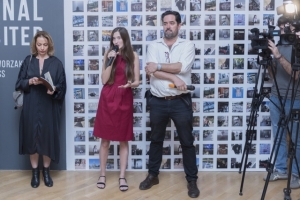TBC Presents: A Russian Journal Revisited and Robert Capa Exhibition
A Russian Journal Revisited - a project initiated by the Magnum Photo Agency, which marks the 70th anniversary of its existence this year, is now open at TBC Bank, alongside a presentation of the works of famous photographer and one of the founders of the agency Robert Capa.
Back in 1947, Capa, together with well-known American writer John Steinbeck, travelled to the USSR, visiting Russia, Ukraine and Georgia, and documenting the lives of people living under the Soviet system, a journey which later transformed into John Steinbeck’s book: A Russian Journal, published in 1948, with photo illustrations by Robert Capa.
Fast forward to 2017, and Magnum Photo Agency decided to mark its anniversary by creating a new, contemporary version of Capa and Steinbeck’s trip to USSR from 70 years ago with a project: A Russian Journal Revisited, made by Thomas Dworzak, German photographer, the president of the agency, and Julius Strauss, British journalist, former Bureau Chief of the Daily Telegraph Moscow office, who also worked as a foreign correspondent from Kosovo to Afghanistan.
This August, over a period of four weeks, Thomas Dworzak and Julius Strauss travelled to Russia, Ukraine and Georgia, following in the footsteps of Steinbeck and Capa. They also visited Sukhumi, Abkhazia as the part of their trip; the journey resulting in an impressive photo exhibition and the album published with Thomas Dworzak’s photos and Julius Strauss’s writings, as they retrace the same trip from 70 years ago. This is combined with another exhibition of Capa’s photos now available for viewing at TBC gallery and TBC Art Gallery at Marjanishvili street, Tbilisi; the exhibitions organized within the framework of the Tbilisi International Photo Festival.
As part of the event, a public lecture by Cynthia Jang was held, covering Robert Capa’s journey to the Soviet Union in 1947.
‘Two things were the most challenging; one was the shadow of Capa, because he was so big, and it would be a bit pretentious to beat him, and the other thing was, that because I lived in Georgia and Russia, I was not new here so I had to find a new perspective,” Thomas Dworzak told us at the opening, when asked what he thought was among the most difficult parts of the project.
“I think I found something more than I was expecting, although I still have to work on it” He said, talking about his own expectations from the project. “I still need to work on it, I only finished shooting one week ago and it needed some time to edit and maybe change the sequence,” he said, sharing the rush and the excitement of the exhibition.
“I really like the photo with the guy dressed in a Caucasian traditional dress, walking in Moscow,” Dworzak told us pointing to one of his works, when asked about the images that still seem most vivid to him and indeed if when one looks at the photo images from Russia, Ukraine and Georgia, you see the traces of history and modernity interlinked, so vibrantly, dramatically even, creating a mosaic of an outstanding record of our time.
“Initially when we started working on the project with Magnum Photo Agency, it had been decided to exhibit the works of Robert Capa as well, and as today in a way marks the finalization of the project, it’s also brings an important message and a parallel from the famous works of Robert Capa to Tomas Dworzak’s recent ones”, Nina Akhvlediani, Art Curator at TBC Bank told us. Capa’s works have been kept at TBC Bank for many years now, with a number of exhibitions already organized; the two exhibitions introducing Dworzak’s and Capa’s work brings a “totally different perspective,” Akhvlediani said.
Eka Enukidze, Magnum Photos representative in Georgia, notes that the project gives “a unique possibility to see what has changed for the 70-year period in the region, while revisiting and representing the landmarks of the history of photography.”
As it traces back to the Soviet reality documented by Steinbeck and Capa, the Russian Journal Revisited project continues to the modernity through the sharp prism of Thomas Dworzak’s works.
By Nino Gugunishvili











